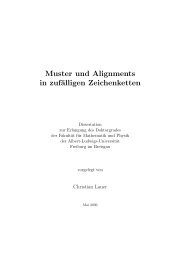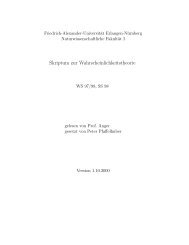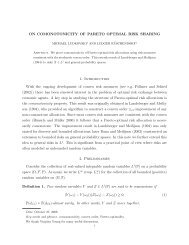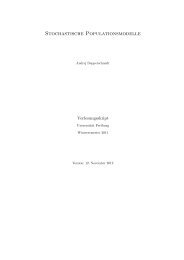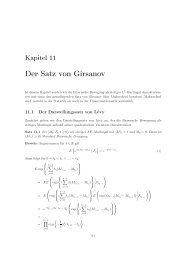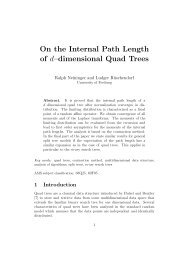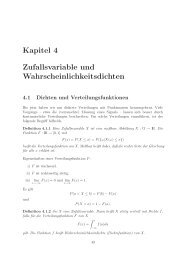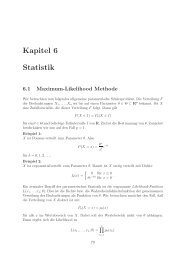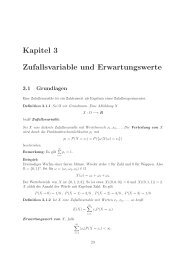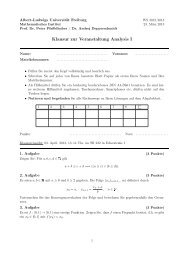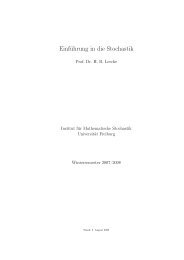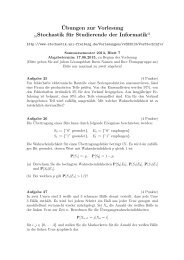Analysis of Markov chain algorithms on spanning trees, rooted ...
Analysis of Markov chain algorithms on spanning trees, rooted ...
Analysis of Markov chain algorithms on spanning trees, rooted ...
You also want an ePaper? Increase the reach of your titles
YUMPU automatically turns print PDFs into web optimized ePapers that Google loves.
J. Fehrenbach and L. Rüschendorf 17<br />
❞ ❢❞<br />
<br />
❞ ❢❞<br />
<br />
❞ <br />
v w✓<br />
✏f<br />
❞<br />
❞ e ❞<br />
<br />
✒ ✑<br />
u<br />
❞ ❞ ❞ ❞ ❢<br />
❞ ❞ ❞ ❢ <br />
❞<br />
❅<br />
❅<br />
❢❞ ❞<br />
Figure 5: In the middle part we have node w c<strong>on</strong>nected via e, f with v and<br />
u in M. Boundary nodes = 0, inner nodes = ❡❝ .<br />
❞ ❢❞ ❞<br />
<br />
v<br />
❞ ❢❞ v ′′ ′<br />
❞ ❞<br />
s v<br />
<br />
❞ <br />
f<br />
s u<br />
❞ ❞ ❞ ❞ ❢<br />
u ′ ❞ ❞ <br />
<br />
❞ ❢ ❞<br />
❢❞ ❞<br />
u ′′<br />
Figure 6: Corresp<strong>on</strong>ding subgraphs s v and s u . Determining the index <str<strong>on</strong>g>of</str<strong>on</strong>g> node<br />
w <str<strong>on</strong>g>of</str<strong>on</strong>g> degree 2. In s v all paths from v ′ to boundary nodes coincide <strong>on</strong> initial<br />
edge part up to v ′′ . Neighbour <str<strong>on</strong>g>of</str<strong>on</strong>g> v ′′ = |. Analogously in s u . The smaller index<br />
<str<strong>on</strong>g>of</str<strong>on</strong>g> the |-node is attached to w.<br />
After this involved determinati<strong>on</strong> <str<strong>on</strong>g>of</str<strong>on</strong>g> the starting point we can follow the<br />
c<strong>on</strong>structi<strong>on</strong> <str<strong>on</strong>g>of</str<strong>on</strong>g> multicommodity flows in secti<strong>on</strong> 3 and c<strong>on</strong>struct can<strong>on</strong>ical<br />
paths for the <str<strong>on</strong>g>Markov</str<strong>on</strong>g> <str<strong>on</strong>g>chain</str<strong>on</strong>g> M s .<br />
C<strong>on</strong>structi<strong>on</strong> <str<strong>on</strong>g>of</str<strong>on</strong>g> can<strong>on</strong>ical paths in M s (G): For X, Y ∈ ST(G) and M :=<br />
(V, X ∪Y ) / (X ∩Y ) let F G<br />
be the multi-commodity flow <str<strong>on</strong>g>of</str<strong>on</strong>g> M s (G) as in secti<strong>on</strong><br />
3. The can<strong>on</strong>ical path γ<br />
XY<br />
form X to Y in M s (G) is defined by inducti<strong>on</strong><br />
<strong>on</strong> |M|: If |M| = 2 then X and Y are neighbours and the can<strong>on</strong>ical path<br />
is γ<br />
XY<br />
= (B i ) 0≤i≤1<br />
, B 0 := X, B 1 = Y . Since F G (γ<br />
XY<br />
) = 1 we choose the<br />
corresp<strong>on</strong>ding coding ¯B 0 := Y , ¯B1 := X. For the inducti<strong>on</strong> step |M| = l + 1<br />
we proceed as in the c<strong>on</strong>structi<strong>on</strong> <str<strong>on</strong>g>of</str<strong>on</strong>g> F G . There however we determined for any<br />
node v the set D <str<strong>on</strong>g>of</str<strong>on</strong>g> G all nodes <str<strong>on</strong>g>of</str<strong>on</strong>g> minimal degree in M, X v , Y v ∈ ST(G),<br />
c<strong>on</strong>structed for any path p ′ ∈ P XvYv with F G (p ′ ) > 0 a path p ∈ P XY and<br />
determined f XY (p) as sum <str<strong>on</strong>g>of</str<strong>on</strong>g> all f XvYv (p ′ ) over all v ∈ D and p ′ ∈ P XvYv<br />
normed<br />
by 1 . Now by inducti<strong>on</strong> hypothesis we have for the starting node v |D| 0 <str<strong>on</strong>g>of</str<strong>on</strong>g> M<br />
and the corresp<strong>on</strong>ding X ′ := X v0 , Y ′ := Y v0 that there exists already exactly<br />
<strong>on</strong>e can<strong>on</strong>ical path γX ′ Y ′. Like the c<strong>on</strong>structi<strong>on</strong> <str<strong>on</strong>g>of</str<strong>on</strong>g> p ∈ P XY from p ′ ∈ P XvY v<br />
we<br />
obtain a can<strong>on</strong>ical path γ<br />
XY<br />
from γX ′ Y ′ and the coding <str<strong>on</strong>g>of</str<strong>on</strong>g> a transiti<strong>on</strong> (B i, B i+1 )<br />
in γ<br />
XY<br />
is given in the same way by ¯B i := X ⊕ Y ⊕ B i . The set <str<strong>on</strong>g>of</str<strong>on</strong>g> all can<strong>on</strong>ical<br />
paths in M s (G) we denote by Γ G .<br />
We next obtain results analogously to Lemma 3.1 and Theorem 3.2. The<br />
can<strong>on</strong>ical path γ<br />
XY<br />
and γX ′ Y ′ are similar if the pairs X, Y and X′ , Y ′ are close.<br />
Lemma 4.1 Let X, Y ∈ ST(G) and w a node <str<strong>on</strong>g>of</str<strong>on</strong>g> degree 3 in M. If a, b ∈ Y



